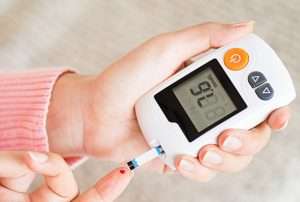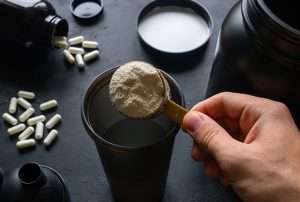How Does A Plant-Based Protein Diet Help in Diabetes?

Both type 1 and type 2 diabetes are chronic in nature. The disease affects your body by disrupting the way blood sugar levels regulated in the body. Studies show that a healthy plant-based diet is effective for managing diabetes.
Glucose is the fuel, that feeds the cells in your body and insulin are the receptors that help glucose enter the cells in the first place.
Therefore, insulin is the key hormone responsible for the production of glucose in the body affecting both type 1 and type 1 form of diabetes.
Type 2 diabetes is more common than type 1 diabetes and the number of people with type 2 diabetes is expected to get double by 2030.
Type 1 and Type 2 Diabetes

People with type 1 diabetes face the problem of not producing enough insulin. The reason for this is generally attributed to genetics and environmental factors.
In this case, the immune system starts attacking and destroying the insulin-producing cells in the pancreas. After which the body is unable to produce insulin. Issues generally surface with people over the age of 30.
Therefore, people with type 1 diabetes have to resort to injecting insulin into their body several times a day.
People with type 2 diabetes face a different kind of problem. Their body still produces insulin but is unable to function the way it should. In other words, it’s unable to filter glucose efficiently and pass it to other parts of the body. As a result, glucose gets accumulated in the bloodstream.
In this case, the body gets resistant to insulin. It is unclear as to why the body gets resistant to insulin in some cases but contributing factors point towards inactivity and excess weight to be the causes. Genetic and environmental factors also play a big role in type 2 diabetes.
Type 2 diabetes can be reversed with diet and exercise alone, but in case one needs extra support, doctors may prescribe medications to use insulin more effectively.
Diabetes Diet Plan

Nutritional management is critical for people living with diabetes.
For people with type 1 diabetes, it is advisable to work out a diet with your doctor since carbohydrate levels can cause blood sugar levels to increase quickly. This can be counteracted by taking insulin but to figure out how much is needed one must consult their physician.
People with type 2 diabetes should focus more on healthy eating since weight loss is usually a part of the treatment plan. Thus following a plant-based diet for diabetes can prove quite beneficial.
1. Get the Fruit Facts right

Fruits are usually labelled as sugar but it’s important to know the specifics.
Fruits contain natural sugar known as fructose. However, unlike processed foods fruits contain high-density of micronutrients like
- Vitamins
- Minerals
- Water
- Fiber
- Antioxidants
- Phytochemicals
The key point to note here is one should know how much to eat and how to pair fruits with healthy fats and proteins.
A single serving of fruit is known to contain 15 to 30 grams of carbs, depending on the type.
Consuming fruits with protein or healthy fats or both have been shown to lower the Glycemic Index of fruits, which is good for maintaining steady blood sugar levels.
Current daily recommendations of fat intake for diabetic patients are 20 to 25 per-cent of total calories, with a focus on unsaturated fats.
2. Eliminate ‘empty ’ Carbs

In addition to fruits, nutrient-dense foods include starchy and non-starchy vegetables and legumes like beans, lentils and peas which are packed with anti-inflammatory phytochemicals.
Make sure to eliminate nutrient-poor, processed foods as it can cause rapid blood sugar swings and lead to an increased need for oral medications and insulin. Some of the food items to avoid are:
- Refined breads
- Crackers
- Traditional pastas
- Cookies
- Pastries
- Glucose and fructose-sweetened beverages
3. Know Your Fats

It’s important to differentiate between the types of fats and how they influence insulin resistance and risk of diabetes.
1. Trans Fats
Trans fats are natural fats which can be found in beef, pork, lamb, butter and milk in small quantities. But a majority of Trans fats are mostly found in partially hydrogenated vegetable oils. Look out for cakes, pies, doughnuts, crackers, microwave popcorns and the likes.
2. Saturated Fats
‘Saturated fats’ is usually a debated topic in the health and fitness community. Low carb advocates of keto and paleo diets favour the consumption of saturated fats by arguing that saturated fats improve diabetes health and promote optimal metabolic health.
But whole-food, plant-based diet for diabetes resort to asserting that diets high in saturated fats increase the risk of diabetes-related problems like:
- High blood pressure
- Weight gain
- High cholesterol
- Insulin resistance
- Coronary artery disease
- Chronic kidney disease
3. Unsaturated Fats
Unsaturated fats include essential fatty acids (EFAs), which are important to regulate many critical physiological functions like:
- Blood clotting
- Immunity
- Blood pressure control
- Inflammation
- Cell division
- Pain control
There are two “parent” EFAs that our bodies can’t manufacture and therefore should get it from diet.
- Omega-6
- Omega-3
Even though plant-based whole food diets contain less Omega-3 than Omega-6, the same can ve substituted by eating 1 tbsp of flaxseeds or ground chia seeds a day.
4. Switch to Plant Proteins

Proteins are needed to enable cell function, maintain, rebuild and repair muscles.
As compared to processed foods (high carbs), proteins shakes are a healthful option as they are absorbed in the body more slowly.
Proteins might help people with type 2 diabetes to lose weight. Make sure to include fresh fruits, vegetables and wholegrain foods (aka fiber) to your plant-based diet for diabetes as well.
Adding oatmeal, fruits and yoghurts with protein shakes is as good as a meal and can be used as a meal replacement for weight loss.
Make sure to check for the sugar content before consuming any form of protein supplements.
Protein powders can be mixed with water, but other healthier options may include
- Nut milk
- Soy milk
- Seed milk
- Cow milk
You can follow this quick recipe to get started:
- One cup of chosen dairy or non-dairy milk
- Frozen or fresh fruit – half a cup
- one scoop of unsweetened Plix Protein Powder – Café Mocha
- Two to three ice cubes
Mix all the ingredients in a blender until they are smooth and serve it chilled.
You can also buy our plant protein powder from Amazon here:














